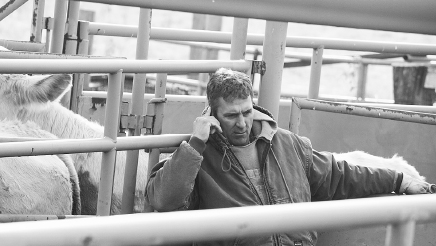Thoughts from
Justin’s Side of the Fence
by Justin Angell

Is beef too high? This is the question I’ve been repeatedly asked this week. Like everything else, beef in the stores costs substantially more than it has for the last five years. A small supply and a big demand is the reason plain and simple. In addition to the inflation, consumers’ perception of much higher beef prices today is compounded by the fact that for the previous five years we liquidated so many cows that beef was inordinately abundant, therefore cheaper than it would normally have been.
The pendulum swings back and now beef appears to be higher than it actually is.
So again, is beef too high? The principle of substitution would say that it is not. As long as consumers keep buying beef, basic capitalism says that it is not. It’s not like beef is absolutely an essential life dependent protein, there are cheaper options.
One final way to answer the question is beef too high is through comparison. Ground beef at $7 per pound has a great deal more nutritional value than a seven-dollar latte. A pound of seven-dollar ground beef is still a lot cheaper than whatever a bag of potato chips costs per pound. Or let’s compare this; I received a call from a reader recently who reminisced that in 1974 he sold seven fed steers and took that check to town and bought a new pickup.
We could obviously go on forever, but I think everyone gets the point. So after reading this, what is your answer to the question, “Is beef too high?”
President Trump, love him or hate him, is an oversized influence on everything. Recently, his comments concerning government efforts to reduce the price of beef, have roiled the futures markets and paused the price appreciation of yearlings heading to the feed-yard, but the always optimistic backgrounders added $5 to $25 cwt to the live calf prices.
Normally calf prices fall off this time of year due to overwhelming volume and pending winter weather, but so far this fall calf markets have been on a steady increase bucking that lower seasonal trend. In today’s market, it’s not uncommon for lighter calves to bring over five dollars per pound with peewee flyweights at $6.00.
The big yearlings, although a little bit cheaper, will still garner prices near $4 per pound.
Bred middle age and younger cows are generally priced from $4000 up. Interestingly, these cows are actually cheaper historically in relation to calf prices. The old rule of thumb was the value of two 500 pound calves should pay for a good bred cow. What’s today’s calf market? It’s not unusual for those calves to be worth $2250-$2500, so accordingly, a bred cow under $4500 is a bargain.
Going back to President Trump efforts, I agree with the premise that the middle class is under pressure and any actions the government can take to decrease expenses for these families is based with good intentions. When it comes to our huge beef industry, Donald Trump‘s team needs to tread carefully, because we all know no government program has ever functioned where there weren’t unintended consequences.
Importing beef from all over the world is like feeding a man for a day… it’s temporary.
If you want to feed that man for a lifetime, besides teaching him to fish, let’s change government policies with executive orders, opening up CRP ground in the Midwest and BLM ground in the West for grazing. The only way to permanently address beef supplies is to increase the number of cows.
The only way we can increase the number of cows is if we’ve got someplace to put them.
If you happen to have President Trump‘s phone number, text him and let him know the unofficial Cattleman’s Advocate policy position.
My bottom line is this. Importing beef from Argentina, although the optics look bad and the messaging out of the White House has been very poor, I don’t believe Argentine beef imports will significantly hurt American beef producers and here’s why. Argentina, an American ally, will primarily be replacing lean beef that previously has been sourced from Brazil, a Chinese ally, and one of the founding members of the BRICS organization.
Because of the Trump tariffs this Brazilian source of lean beef has been curtailed by tariffs.
As a matter of fact, imported cheap lean beef is actually good for both consumers and producers of American beef. Currently our overfed, huge carcasses actually have a significant amount of very low value excess fat being trimmed off every carcass. Cheap, imported lean beef blended with the excess low value fat significantly increases the value of the excess fat by producing hamburger — an American family staple. So yes, ironically, the imported lean beef increases the value of overfed American beef carcasses by taking very low value fat and turning it into a high value burger product.
Cutting it a little short this month. With harvest running full-bore, there’s not a lot of marketing action locally to comment on. This all changes soon. That’s all for this month. Come see me at the auction.